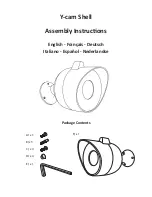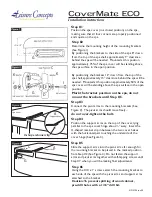
12. Cut off the excess wire that extends past the end of the nozzle.
13. Fine tune the wire drive pressure with the pressure arm adjustment knob (G).
a. Turn the wire drive pressure adjustment knob clockwise, increasing the drive pressure until the wire seems to feed smoothly
without slipping.
NOTE: If TOO MUCH pressure is applied you can crush the wire and create wire feeding problems. If TOO LITTLE pres-
sure is applied, the wire will slip on the drive rolls and wire will not feed.
b. When the drive pressure is set correctly, there should be no slippage between the wire and the drive roller. But if an obstruc-
tion occurs along the wire feed path, the wire should then slip on the drive roller. This can be checked by squeezing the wire be-
tween two fingers with moderate force as it comes out of the gun. If this stops the wire from feeding, increase pressure until the
wire feeds through your fingers without issue.
14. Double check your spool tension: After feeding the wire and releasing the trigger, the wire coming off the spool should not re-
main under tension (in a straight line from the spool to the WIRE FEEDER). It should relax a little bit and take on some of the
curvature the coiled wire naturally reverts to. It should also not relax so much that the wire begins to loosen on the spool.
KEEP THE GUN STRAIGHT. WHEN FEEDING A NEW WIRE THROUGH THE LINER, MAKE SURE THE WIRE IS CUT
CLEANLY (NO BURRS OR ANGLES) AND THAT AT LEAST 1" FROM THE END IS STRAIGHT (NO CURVES). FAILURE
TO FOLLOW THESE INSTRUCTIONS COULD CAUSE DAMAGE TO THE LINER.
WHEN CHECKING THE CORRECT EXIT OF THE WIRE FROM THE GUN DO NOT BRING YOUR FACE NEAR THE
GUN. YOU MAY RUN THE RISK OF BEING WOUNDED BY THE OUTGOING WIRE. DO NOT BRING YOUR FINGERS
CLOSE TO THE FEEDING MECHANISM WHEN WORKING! THE ROLLS, WHEN MOVING, MAY CRUSH FINGERS. PE-
RIODICALLY CHECK THE ROLLS. REPLACE THEM WHEN THEY ARE WORN AND COMPROMISE THE REGULAR
FEEDING OF THE WIRE.
On the machine, there is a plate that includes all the operating specifications for your new unit.
The duty cycle rating of a welder defines how long the operator can weld and how long the welder must rest and be cooled. Duty cy-
cle is expressed as a percentage of 10 minutes and represents the maximum welding time allowed. The balance of the 10-minute
cycle is required for cooling.
For example, a welder has a duty cycle rating of 30% at the rated output of 90A. This means with that machine, you can weld at 90
A output for three (3) minutes out of 10 with the remaining seven (7) minutes required for cooling.
The duty cycle of your new welder can be found on the data plate affixed to the machine. It looks like the diagram below. Referring
to the sample below, the “X” row lists duty cycle percentages while the “I2” row lists the amp draw corresponding to the duty cycle.
Various duty cycles at other amperages are listed on your data plate.
CORRECT
INCORRECT
- 12 -
Performance Data Plate And Duty Cycle
OPERATION
Содержание MIG-205DS
Страница 2: ......
Страница 26: ...WIRING DIAGRAM 23...
Страница 27: ......
Страница 28: ...www yeswelder com WE ALWAYS STAND BEHIND IT Toll Free 855 937 4567...














































